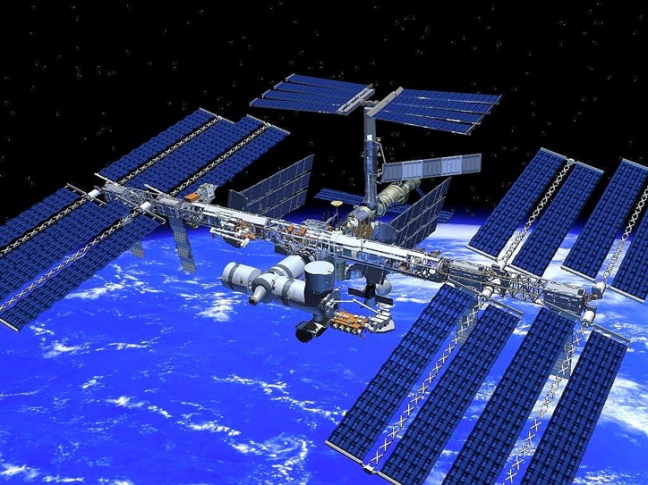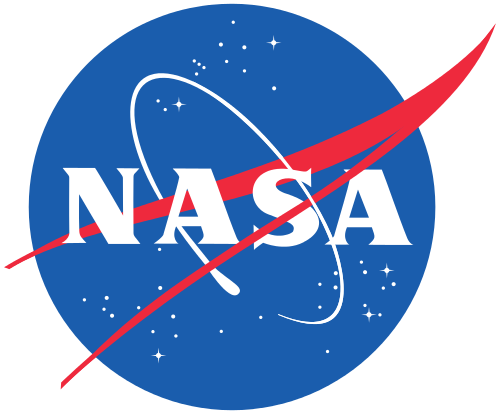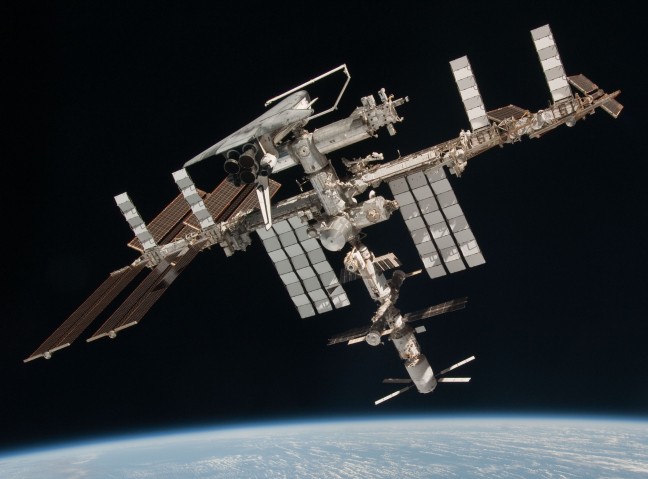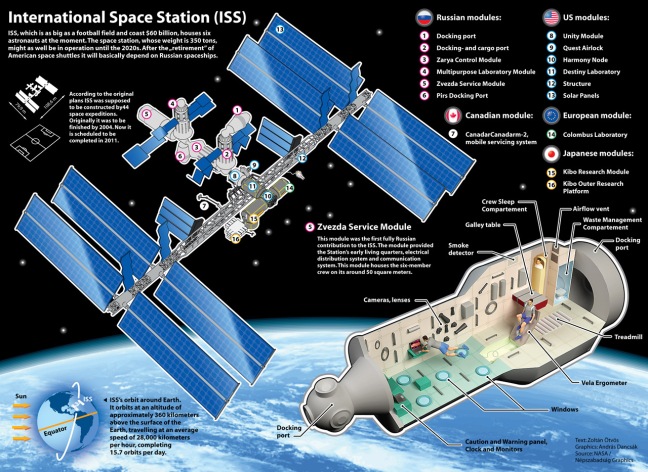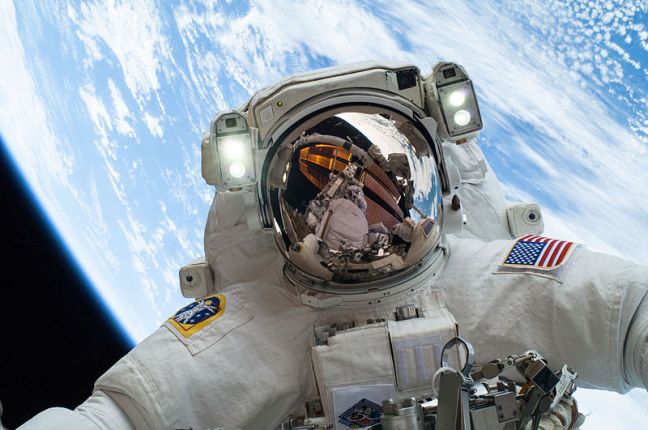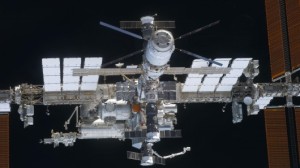Definition:
The International Space Station is a large spacecraft. It orbits around Earth. It is a home where astronauts live.
The space station is also a science lab. Many countries worked together to build it. They also work together to use it.
The space station is made of many pieces. The pieces were put together in space by astronauts. The space station’s orbit is about 220 miles above Earth. NASA uses the station to learn about living and working in space. These lessons will help NASA explore space.
NASA:
The National Aeronautics and Space Administration (NASA) is the agency of the United States government that is responsible for the nation’s civilian space program and for aeronautics and aerospace research.
Since that time, most U.S. space exploration efforts have been led by NASA, including the Apollo moon-landing missions, the Skylab space station, and later the Space Shuttle. Currently, NASA is supporting the International Space Station and is overseeing the development of the Orion Multi-Purpose Crew Vehicle, the Space Launch System and Commercial Crew vehicles. The agency is also responsible for the Launch Services Program (LSP) which provides oversight of launch operations and countdown management for unmanned NASA launches.
How Old Is the Space Station…..???
The first piece of the International Space Station was launched in 1998. A Russian rocket launched that piece. After that, more pieces were added. Two years later, the station was ready for people. The first crew arrived in October 2000. People have lived on the space station ever since. Over time more pieces have been added. NASA and its partners around the world finished the space station in 2011
The space station is a home in orbit. People have lived in space every day since the year 2000. The space station’s labs are where crew members do research. This research could not be done on Earth.
Scientists study what happens to people when they live in space. NASA has learned how to keep a spacecraft working for a long time. These lessons will be important in the future.
NASA has a plan to send humans deeper into space than ever before. The space station is one of the first steps. NASA will use lessons from the space station to get astronauts ready for the journey ahead.
How Big Is the Space Station…..????
Three crew members pose on the space station, with one upside-down
Pictured here are members of the 17th crew to live aboard the space station.
The space station is as big inside as a house with five bedrooms. It has two bathrooms, a gymnasium and a big bay window. Six people are able to live there. It weighs almost a million pounds. It is big enough to cover a football field including the end zones. It has science labs from the United States, Russia, Japan and Europe.
Once completed, the dimensions of the International Space Station (ISS) will be approximately 108.5 meters by 72.8 meters. This is slightly larger then a full sized soccer field. The completed ISS will weigh around 450 tons. A small passenger car weighs approximately 1 ton. So, the ISS is 450 times heavier than a car.
What Are the Parts of the Space Station….????
The space station has many parts. The parts are called modules. The first modules had parts needed to make the space station work. Astronauts also lived in those modules. Modules called “nodes” connect parts of the station to each other. Labs on the space station let astronauts do research.
On the sides of the space station are solar arrays. These arrays collect energy from the sun. They turn sunlight into electricity. Robot arms are attached outside. The robot arms helped to build the space station. They also can move astronauts around outside and control science experiments.
Airlocks on the space station are like doors. Astronauts use them to go outside on spacewalks.
Docking ports are like doors, too. The ports allow visiting spacecraft to connect to the space station. New crews and visitors enter the station through the docking ports. Astronauts fly to the space station on the Russian Soyuz. The crew members use the ports to move supplies onto the station.
Exploration:
A 3D plan of the Russia-based MARS-500 complex, used for ground-based experiments which complement ISS-based preparations for a manned mission to Mars.
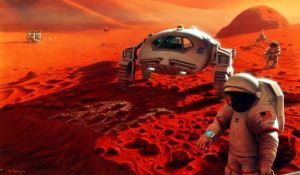
The ISS provides a location in the relative safety of Low Earth Orbit to test spacecraft systems that will be required for long-duration missions to the Moon and Mars. This provides experience in operations, maintenance as well as repair and replacement activities on-orbit, which will be essential skills in operating spacecraft farther from Earth, mission risks can be reduced and the capabilities of interplanetary spacecraft advanced.[14] Referring to the MARS-500 experiment, ESA states that “Whereas the ISS is essential for answering questions concerning the possible impact of weightlessness, radiation and other space-specific factors, aspects such as the effect of long-term isolation and confinement can be more appropriately addressed via ground-based simulations”.Sergey Krasnov, the head of human space flight programmes for Russia’s space agency, Roscosmos, in 2011 suggested a “shorter version” of MARS-500 may be carried out on the ISS.
In 2009, noting the value of the partnership framework itself, Sergey Krasnov wrote, “When compared with partners acting separately, partners developing complementary abilities and resources could give us much more assurance of the success and safety of space exploration. The ISS is helping further advance near-Earth space exploration and realisation of prospective programmes of research and exploration of the Solar system, including the Moon and Mars.” A manned mission to Mars, however, may be a multinational effort involving space agencies and countries outside of the current ISS partnership. In 2010 ESA Director-General Jean-Jacques Dordain stated his agency was ready to propose to the other 4 partners that China, India and South Korea be invited to join the ISS partnership. NASA chief Charlie Bolden stated in Feb 2011 “Any mission to Mars is likely to be a global effort”. Currently, American legislation prevents NASA co-operation with China on space projects.
Station operations:
Zarya and Unity were entered for the first time on December 10, 1998.
Soyuz TM-31 being prepared to bring the first resident crew to the station in October 2000
ISS was slowly assembled over a decade of spaceflights and crews
Expeditions have included male and female crew-members from many nations
See also the list of International Space Station expeditions (professional crew), space tourism (private travellers), and the list of human spaceflights to the ISS (both).
Each permanent crew is given an expedition number. Expeditions run up to six months, from launch until undocking, an ‘increment’ covers the same time period, but includes cargo ships and all activities. Expeditions 1 to 6 consisted of 3 person crews, Expeditions 7 to 12 were reduced to the safe minimum of two following the destruction of the NASA Shuttle Columbia. From Expedition 13 the crew gradually increased to 6 around 2010. With the arrival of the American Commercial Crew vehicles in the middle of the 2010s, expedition size may be increased to seven crew members, the number ISS is designed for.
Sergei Krikalev, member of Expedition 1 and Commander of Expedition 11 has spent more time in space than anyone else, a total of 803 days and 9 hours and 39 minutes. His awards include the Order of Lenin, Hero of the Soviet Union, Hero of the Russian Federation, and 4 NASA medals. On 16 August 2005 at 1:44 am EDT he passed the record of 748 days held by Sergei Avdeyev, who had ‘time travelled’ 1/50th of a second into the future on board MIR. He participated in psychosocial experiment SFINCSS-99 (Simulation of Flight of International Crew on Space Station), which examined inter-cultural and other stress factors affecting integration of crew in preparation for the ISS spaceflights. Commander Michael Fincke has spent a total of 382 days in space – more than any other American astronaut.
Life aboard:
Crew activities:
A typical day for the crew begins with a wake-up at 06:00, followed by post-sleep activities and a morning inspection of the station. The crew then eats breakfast and takes part in a daily planning conference with Mission Control before starting work at around 08:10. The first scheduled exercise of the day follows, after which the crew continues work until 13:05. Following a one-hour lunch break, the afternoon consists of more exercise and work before the crew carries out its pre-sleep activities beginning at 19:30, including dinner and a crew conference. The scheduled sleep period begins at 21:30. In general, the crew works ten hours per day on a weekday, and five hours on Saturdays, with the rest of the time their own for relaxation or work catch-up.
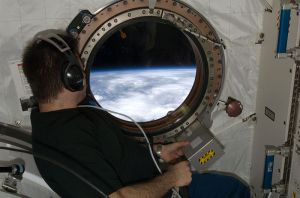
The station provides crew quarters for each member of the expedition’s crew, with two ‘sleep stations’ in the Zvezda and four more installed in Harmony. The American quarters are private, approximately person-sized soundproof booths. The Russian crew quarters include a small window, but do not provide the same amount of ventilation or block the same amount of noise as their American counterparts. A crewmember can sleep in a crew quarter in a tethered sleeping bag, listen to music, use a laptop, and store personal items in a large drawer or in nets attached to the module’s walls. The module also provides a reading lamp, a shelf and a desktop.Visiting crews have no allocated sleep module, and attach a sleeping bag to an available space on a wall—it is possible to sleep floating freely through the station, but this is generally avoided because of the possibility of bumping into sensitive equipment.It is important that crew accommodations be well ventilated; otherwise, astronauts can wake up oxygen-deprived and gasping for air, because a bubble of their own exhaled carbon dioxide has formed around their heads.
Food:
Tomatoes floating in micro-gravity.Most of the food on board is vacuum sealed in plastic bags. Cans are too heavy and expensive to transport, so there are not as many. The preserved food is generally not held in high regard by the crew, and when combined with the reduced sense of taste in a microgravity environment, a great deal of effort is made to make the food more palatable. More spices are used than in regular cooking, and the crew looks forward to the arrival of any ships from Earth, as they bring fresh fruit and vegetables with them. Care is taken that foods do not create crumbs. Sauces are often used to ensure station equipment is not contaminated. Each crew member has individual food packages and cooks them using the on-board galley.
The galley features two food warmers, a refrigerator added in November 2008, and a water dispenser that provides both heated and unheated water.Drinks are provided in dehydrated powder form and are mixed with water before consumption.Drinks and soups are sipped from plastic bags with straws, while solid food is eaten with a knife and fork, which are attached to a tray with magnets to prevent them from floating away. Any food that does float away, including crumbs, must be collected to prevent it from clogging up the station’s air filters and other equipment.
Hygiene:
Space toilet in the Zvezda Service Module
Showers on space stations were introduced in the early 1970s on Skylab and Salyut. By Salyut 6, in the early 1980s, the crew complained of the complexity of showering in space, which was a monthly activity. The ISS does not feature a shower; instead, crewmembers wash using a water jet and wet wipes, with soap dispensed from a toothpaste tube-like container. Crews are also provided with rinseless shampoo and edible toothpaste to save water.
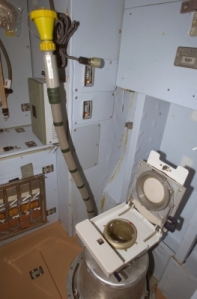
There are two space toilets on the ISS, both of Russian design, located in Zvezda and Tranquility. These Waste and Hygiene Compartments use a fan-driven suction system similar to the Space Shuttle Waste Collection System. Astronauts first fasten themselves to the toilet seat, which is equipped with spring-loaded restraining bars to ensure a good seal. A lever operates a powerful fan and a suction hole slides open: the air stream carries the waste away. Solid waste is collected in individual bags which are stored in an aluminium container. Full containers are transferred to Progress spacecraft for disposal. Liquid waste is evacuated by a hose connected to the front of the toilet, with anatomically correct “urine funnel adapters” attached to the tube so both men and women can use the same toilet. Waste is collected and transferred to the Water Recovery System, where it is recycled back into drinking water.
Future Of ISS:
15 years from now we’ll be thinking about [de-orbiting the ISS],” says Shannon. By then, our knowledge of space exploration will be such that we can safely and effectively expand our sphere of influence in space, and we will have performed groundbreaking science along the way in experiments that couldn’t be replicated on Earth.
When the time comes to bring the curtain down on mankind’s greatest endeavour, we will have kept a continuous presence in space for almost three decades. By that time, we will well and truly be ready to explore new frontiers. “We will have learned what we need to learn about people’s reaction to space so that we can go farther and deeper into space,” concludes Shannon. “I think that’s going to be the legacy of the ISS.”
–
